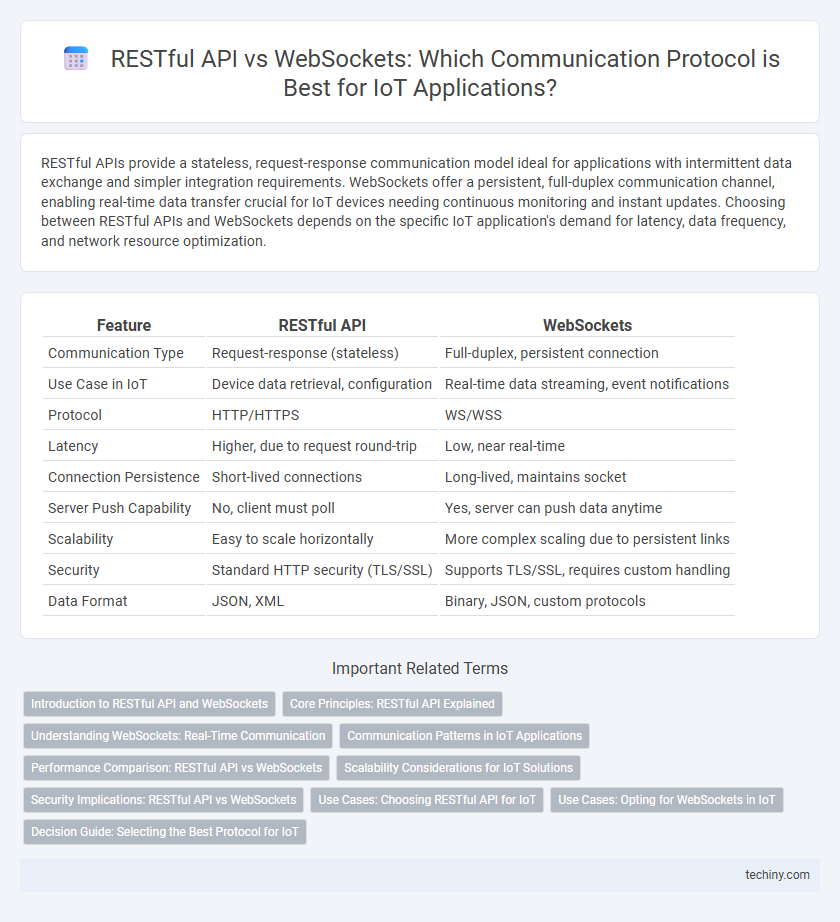RESTful APIs provide a stateless, request-response communication model ideal for applications with intermittent data exchange and simpler integration requirements. WebSockets offer a persistent, full-duplex communication channel, enabling real-time data transfer crucial for IoT devices needing continuous monitoring and instant updates. Choosing between RESTful APIs and WebSockets depends on the specific IoT application's demand for latency, data frequency, and network resource optimization.
Table of Comparison
| Feature | RESTful API | WebSockets |
|---|---|---|
| Communication Type | Request-response (stateless) | Full-duplex, persistent connection |
| Use Case in IoT | Device data retrieval, configuration | Real-time data streaming, event notifications |
| Protocol | HTTP/HTTPS | WS/WSS |
| Latency | Higher, due to request round-trip | Low, near real-time |
| Connection Persistence | Short-lived connections | Long-lived, maintains socket |
| Server Push Capability | No, client must poll | Yes, server can push data anytime |
| Scalability | Easy to scale horizontally | More complex scaling due to persistent links |
| Security | Standard HTTP security (TLS/SSL) | Supports TLS/SSL, requires custom handling |
| Data Format | JSON, XML | Binary, JSON, custom protocols |
Introduction to RESTful API and WebSockets
RESTful API enables IoT devices to communicate through stateless, client-server architecture using standard HTTP methods, facilitating easy integration and scalability. WebSockets provide full-duplex communication channels over a single TCP connection, ideal for real-time, low-latency data exchange in IoT applications. Both protocols support efficient data transmission but differ in connection persistence and communication patterns suitable for various IoT scenarios.
Core Principles: RESTful API Explained
RESTful API in the Internet of Things (IoT) emphasizes stateless communication, resource-based architecture, and standard HTTP methods like GET, POST, PUT, and DELETE. It organizes IoT devices as resources identifiable by URIs, enabling scalable and cacheable interactions conducive to large-scale device management. This architectural style ensures interoperability, simplicity, and uniformity, making RESTful APIs a foundational principle for IoT application development.
Understanding WebSockets: Real-Time Communication
WebSockets provide a full-duplex communication channel over a single TCP connection, enabling real-time data exchange with low latency in Internet of Things (IoT) applications. Unlike RESTful APIs, which operate on a request-response model and can introduce delays, WebSockets maintain persistent connections that support instant messaging and event-driven data updates. This continuous bidirectional communication is essential for IoT devices requiring immediate responsiveness and efficient network resource usage.
Communication Patterns in IoT Applications
RESTful APIs in IoT applications employ a request-response communication pattern, ideal for occasional data retrieval and control commands, emphasizing statelessness and scalability. WebSockets enable full-duplex communication, supporting real-time, bidirectional data streams critical for continuous monitoring and instant device updates in IoT systems. Choosing between these depends on IoT use cases: RESTful APIs suit low-frequency interactions, while WebSockets excel in scenarios demanding immediate, persistent connectivity.
Performance Comparison: RESTful API vs WebSockets
RESTful APIs rely on stateless HTTP requests that incur higher latency due to repeated connection setups, making them less efficient for real-time IoT data transmission. WebSockets establish persistent, full-duplex communication channels that reduce overhead and enable faster, bidirectional data exchange crucial for time-sensitive IoT applications. Performance benchmarks show WebSockets outperform RESTful APIs in throughput and response time, particularly under high-frequency message exchanges in IoT environments.
Scalability Considerations for IoT Solutions
RESTful APIs offer stateless communication that enhances scalability by enabling distributed server architecture and load balancing in IoT solutions. WebSockets provide persistent, bidirectional connections but may face challenges in scaling due to maintaining active sessions and higher resource consumption per device. Selecting the appropriate protocol depends on IoT system requirements, balancing real-time data exchange needs with infrastructure scalability and resource constraints.
Security Implications: RESTful API vs WebSockets
RESTful APIs utilize stateless HTTP protocols, making them inherently resilient to certain security threats like session hijacking but require robust authentication and authorization mechanisms such as OAuth or JWT for secure access control. WebSockets maintain persistent bi-directional connections, increasing the surface for attacks like cross-site WebSocket hijacking and requiring secure protocols like WSS (WebSocket Secure) combined with stringent origin checks and token validation. Both technologies necessitate encryption via TLS/SSL to safeguard data in transit and mitigate risks of eavesdropping and man-in-the-middle attacks in IoT environments.
Use Cases: Choosing RESTful API for IoT
RESTful API is ideal for IoT applications requiring stateless, request-response communication, such as device configuration, data retrieval, and command execution on demand. It excels in environments with intermittent connectivity and where simple, scalable interactions are necessary, like smart home systems and industrial sensors. RESTful APIs offer broad compatibility and easier integration with existing web services, making them suitable for diverse IoT ecosystems.
Use Cases: Opting for WebSockets in IoT
WebSockets enable real-time, bidirectional communication essential for IoT applications such as remote device monitoring, live data streaming, and control systems where immediate responsiveness is crucial. Unlike RESTful APIs, which rely on request-response cycles and can introduce latency, WebSockets maintain persistent connections that reduce overhead and enhance efficiency in managing numerous IoT devices. This makes WebSockets particularly suitable for use cases involving continuous data exchange and instant event notifications in smart home automation, industrial IoT, and connected vehicles.
Decision Guide: Selecting the Best Protocol for IoT
For IoT applications, RESTful APIs excel in simplicity and stateless communication, ideal for devices with intermittent connectivity and requirement for standardized CRUD operations. WebSockets offer full-duplex, low-latency communication suited for real-time data exchange and continuous device interaction, crucial for applications like live sensor monitoring and instant control commands. Decision-making depends on factors such as latency tolerance, bidirectional communication needs, power consumption constraints, and the complexity of message handling within the IoT ecosystem.
RESTful API vs WebSockets Infographic

 techiny.com
techiny.com